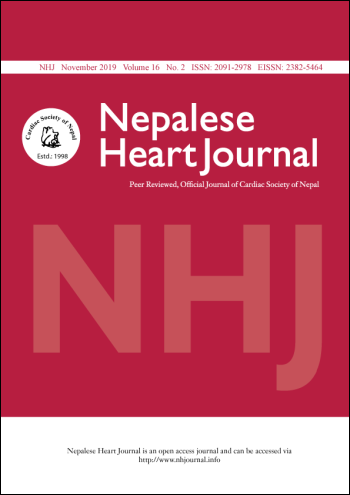High dose versus low dose Aspirin after Percutaneous Coronary Intervention in Coronary Artery Disease
DOI:
https://doi.org/10.3126/njh.v16i2.26319Keywords:
APD acid peptic disease, CAD coronary artery disease, CV cardiovascular, GI gastrointestinal, PCI percutaneous coronary interventionAbstract
Background and Aims: Patients with Coronary artery disease who undergo percutaneous coronary intervention (PCI) are prescribed with maintenance aspirin dose that vary between 75 mg to 300 mg daily. The objective of this study is to evaluate the effects of high dose versus low dose aspirin doses prescribed on hospital discharge in PCI.
Methods: All the patients who had undergone PCI at our hospital from 2017 February to October 2017 were enrolled in the study. They were divided into two groups receiving low dose (<200mg) aspirin and high dose (>200mg) aspirin. Patients were interviewed on phone after completion of one year for the possible complications and new ischemic events during the follow up period.
Results: Among 150 patients selected 101 fulfilled the criteria and sixty patients (59.4%) were discharged on low-dose aspirin 75-150mg and 41 patients (40.6%) were discharged on high-dose aspirin of 300mg. The mean age in low aspirin group was 59.8±13.19 years and 49.4±10.7 years in high aspirin group. Although high aspirin dose patients did not complain of epigastric pain more often, upper GI bleeding was significantly higher in high aspirin group 7.5% vs 11.1% (p<0.05). One patient in high aspirin group had hemorrhagic stroke while low aspirin group had none. One patient in high aspirin had sudden cardiac death at home. Clinically, there was no significant difference in new ischemic events during follow up period.
Conclusion: In patients with coronary artery disease undergoing PCI, discharge on high-dose rather than low-dose aspirin may increase the rate of bleeding without providing additional ischemic benefit.
Downloads
Downloads
Published
How to Cite
Issue
Section
License
This license enables reusers to distribute, remix, adapt, and build upon the material in any medium or format, so long as attribution is given to the creator. The license allows for commercial use.




